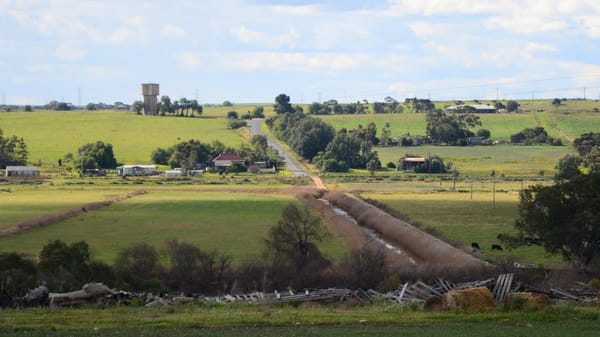What will the River Murray look like by 2100?
Important questions have been asked at a Murray-Darling Association conference in Murray Bridge.

This story was originally published behind Murray Bridge News’ paywall. Paywalled stories are unlocked four weeks after publication. Can’t wait that long? Subscribe here.

It’s going to be a wet spring, according to the Bureau of Meteorology.
It was already raining on Wednesday as river advocates and councillors gathered at the Bridgeport Hotel for a conference of the Murray-Darling Association.
But climate projections suggest that the Murraylands will only get drier during the 21st century.
That’s bad news for the River Murray and the rivers which flow into it.
The Murray-Darling Basin might be the world’s best-managed water system, according to a University of Adelaide professor, but it’s far from perfect.
The gulf between the River Murray’s healthy past and its parched future is as wide as its brown water.
Where will that leave us by 2100?

Remember the Millennium Drought
Tim Hartman remembers the Millenium Drought as a time when his family’s connection to country was interrupted.
He couldn’t gather swan eggs or get a feed of Coorong mullet, as Ngarrindjeri had done for thousands of years; he couldn’t teach his kids about culture and language on camping trips down the Coorong, like the ones he had taken as a child.
“These things are very important,” he said.
“Not only do we pass down our history ... but how do we continue to have knowledge?”
Joanne Pfeiffer remembered the drought scarring her paddocks, turning her drains to acid and shunting her from dairying into beef and hay production.
“We lost the ability to access any water and flood-irrigate our pastures,” she said.
“We lost 35 cows in our cracks ... from broken legs and whatnot.
“We lost a lot of the organic matter in our soils.”
Alexandrina councillor Melissa Rebbeck estimated that only 20 per cent of the Lower Lakes’ ecology had recovered from the drought.
One thing would help it rebound: more water.
Mr Hartman said Ngarrindjeri elders envisioned a future in which the river, lakes and Coorong were as healthy as they had been in their grandparents’ time.
But that vision is getting harder to see.
Twelve thousand gigalitres of water flowed out of the Murray Mouth each year prior to European settlement, SARDI researcher Chris Bice said.
That figure fell to about 1000GL last year.
“There has been some great recovery in recent years, but it really does depend on ... where you’re looking back to,” he said.
“We recovered reasonably well from that (Millennium) drought, but we haven’t recovered from the other impacts that have occurred in the past.
“I think our expectations need to be tempered a bit.”

The future will be dry
Melissa Rebbeck remembers being told as a child that in the future, water would be bottled and precious as the world dried out.
That future had since come to pass.
Now the Alexandrina councillor was frightened about the likely effects of climate change on rainfall, temperatures and the barrages, unless more was done to prevent it.
She did not think that 2750 gigalitres, the amount of water to be recovered for the environment through the Murray-Darling Basin Plan, would not be enough.
“We will have another drought, it will be worse than the last one – that’s what climate scientists are telling us,” she said.
“I don’t think that we are prepared.”
Asked what basin communities could do to prepare for future droughts “without compromising agriculture”, she was blunt: unless new water sources were found, compromises would have to be made.
Commonwealth Environmental Water Office representative Richard Mintern agreed that the basin was heading into “uncharted territory”.
The Murray-Darling Basin Authority’s Brent Williams suggested all water users’ entitlements might eventually be cut.
Wetland expert and irrigator David Willis said there would have to be “confronting” trade-offs and pain shared around.
“There will probably never be more water than what we have now,” he said.
“It’s going to become trickier.”

On the bright side, the basin plan is doing its job
If things are so dire, why haven’t we experienced another Millennium Drought yet, with river banks slumping and cattle falling into cracks in the swamps?
A lot had changed since then, Mr Williams said.
Recent droughts had been shorter; but also the Murray-Darling Basin Plan had saved water and changed the way the environment was managed.
The Murraylands’ wetlands could now handle two or three dry years because they were in a better condition to start with.
“The Millennium Drought was long, very deep, and it destroyed a lot of stuff, hurt a lot of people,” Mr Williams said.
“But for the first five years it wasn’t the Millennium Drought – it was a drought.
“If you get a 10-year drought, the pain is going to come again, but the ecological sites we’ve got well prepared for those short droughts that happen almost all the time.”
Ms Pfeiffer said all water users between Mannum and Wellington had benefited from 22GL of water being set aside to keep river levels from dropping.
“We need the basin plan,” she said.
“We certainly need to make sure below Lock One that we have the basin plan delivered so that we attain ... a successful (water) level in the river.
“Otherwise we’ll just be back where we were, and we don’t want that.”
People living upstream needed to learn about South Australians’ successes at adapting to a drier world, she said.
Conference delegates were scheduled to learn about some of those successes on Thursday, visiting irrigators at Langhorne Creek, the barrages at Goolwa, and meeting farmers on Mundoo Island and Ngarrindjeri representatives at the Murray Mouth.
A video of their journey will be shared among the 100-plus local councils who are MDA members, informing their positions on water policy.

Our water management is ‘the best in the world’ but still needs work
The crunch will come when the Murray-Darling Basin Plan comes up for review in 2026.
University of Adelaide Professor Mike Young, an expert in water policy, suggested a few improvements at an MDA dinner on Wednesday night.
For one thing, he said the basin plan had it all backwards.
Instead of limiting the amount of water humans could take out of the Murray-Darling Basin, we needed to guarantee a minimum amount of water that would stay in, particularly in a changing climate.
The Murray-Darling Basin Authority needed to be more like the Reserve Bank, he said, independent of political interference.
“A truly independent authority would be given a brief to make the brave, hard decisions that need to be made, and would be able to … direct officials to do what needs to be done,” he said.
“Having it the other way around results in a messy system.”






